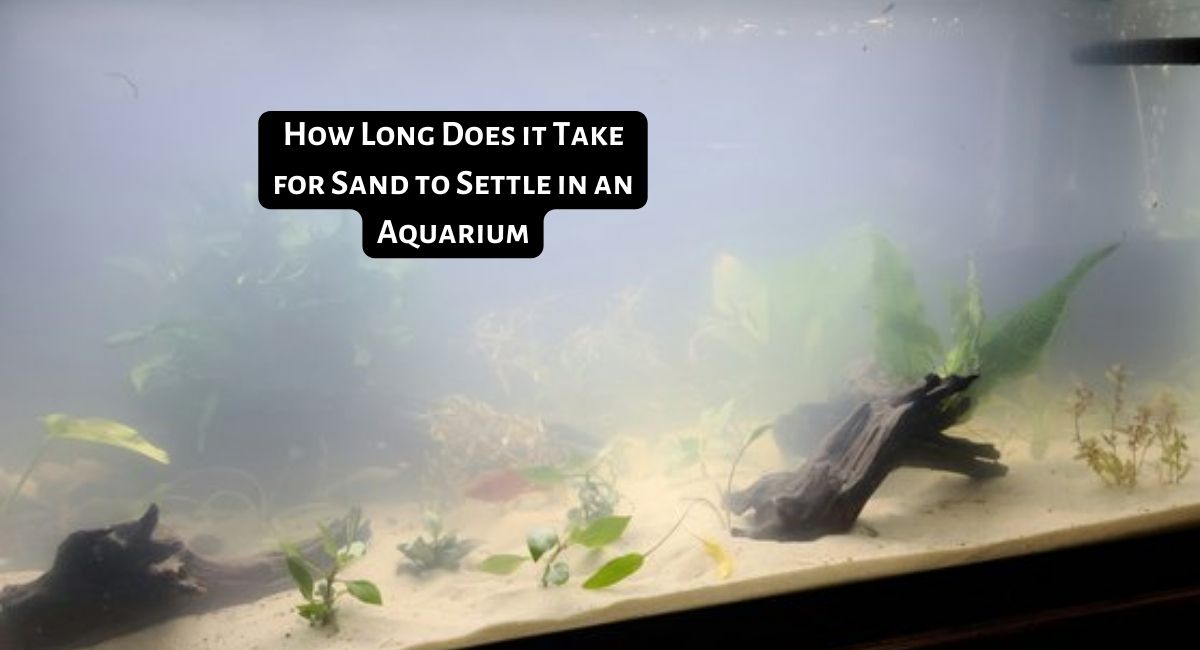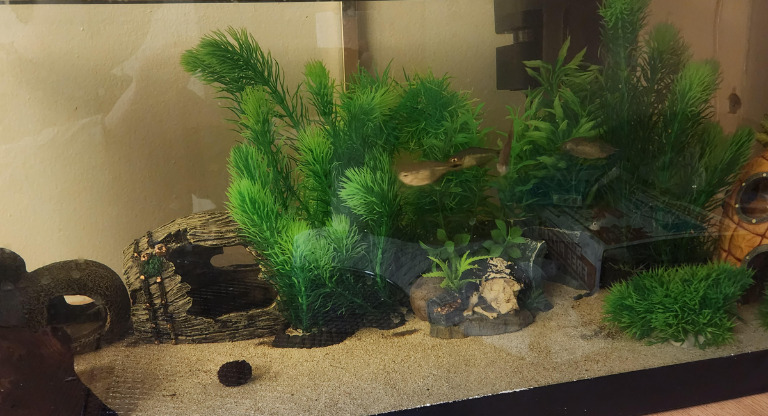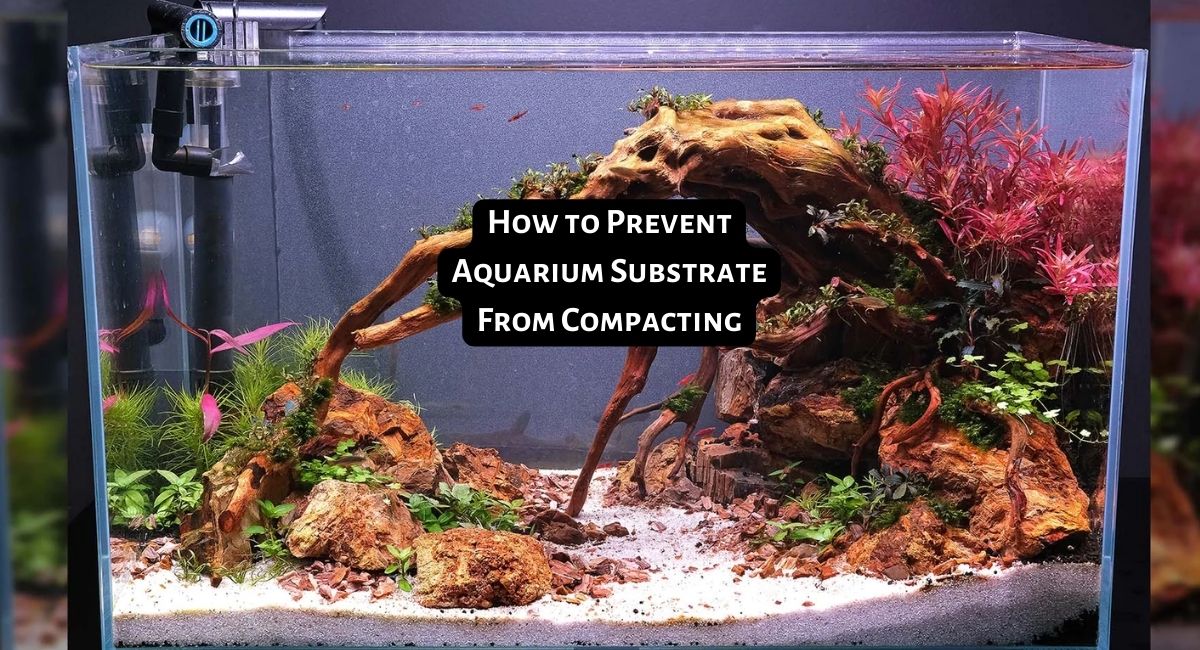Smartplantedaquarium.com participates in affiliate marketing programs. We may earn commissions on purchases made through our affiliate links. This doesn't affect our content or recommendations and we only recommend products we would put in our own tanks.
As an expert in planted aquariums, I’m often asked the same question: “How long does it take for sand to settle in an aquarium?” It’s a common concern among new and experienced aquarists alike, and it’s important to know the answer if you’re looking to set up a beautiful, healthy tank. So let me explain how long it takes for sand to settle in an aquarium.
First off, this process will depend on two main factors: the type of sand you use and the size of your tank. Different types of sands will have varying grain sizes and density levels, which can affect how quickly they settle into place. Additionally, larger tanks may require more time for settling due to their greater volume of water.
TL;DR
Typically, it takes between 2 and 4 weeks for your sand to fully settle and not cloud up your tank when disturbed. During this time, you should be careful not to disturb the sand too much. This means avoiding vacuuming it or moving plants around until after the settling period is over. After that, regular vacuuming and maintenance can help keep your aquarium looking its best! TL;DR: When setting up a planted aquarium, it usually takes 2-4 weeks for the sand to settle fully before regular maintenance can begin. Avoid disturbing the sand during this time for best results.
Contents
How Long Does it Take for Sand to Settle in an Aquarium?
Once you’ve determined the type and size of sand for your aquarium, it’s time to start the process. When you first introduce sand into your tank, the grains will remain suspended in the water for a period of time before gradually settling down to the bottom. Depending on the factors above, this can take anywhere from several hours up to a few days. Once all of the sand has settled, you can begin adding plants or other decorations to complete your aquascape!
How Long Does Sand Take to Settle So You Can Add Fish?
When adding sand to an aquarium, you may be wondering how long it will take for the sand to settle. The amount of time it takes depends on a number of factors, including type and size of aquarium, size and shape of the grains the sand, and whether or water movement is present.
In general, it can take anywhere from one day up to several weeks for newly added sand to settle completely in an aquarium. This is because most types of aquarium sand are made up of very fine particles that need time to move about until they form an even layer at the bottom. If left undisturbed during this settling period, all particles will eventually settle into position.
If there is water movement in the aquarium, such as a filter or pump, it can cause some of the particles to move around and further increase the settling time. To speed up the process, you can reduce water movement by turning off any filters or pumps temporarily while adding sand.
After adding sand to your aquarium, it is important to let it settle for at least 24 hours before introducing new fish or plants into the tank. This gives the sand time to form an even layer and prevents any potential problems with unbalanced pH that could occur if newly added fish were exposed to unsettled sand.
Once your aquarium’s sand has had sufficient time to settle, be sure to check regularly whether it needs cleaning or replacing. It is recommended that you replace aquarium sand every year to maintain proper levels of beneficial bacteria that help support healthy aquatic life.
It can take anywhere from one day up to several weeks for freshly added sand to settle in an aquarium. To speed up the process, reduce water movement and let the sand settle for at least 24 hours before introducing new fish or plants into the tank. With regular maintenance, you can ensure your aquarium’s sand remains healthy and balanced for years to come.
How To Prepare Sand For Aquarium?
Preparing substrate for an aquarium can be a lengthy and tedious process, but is necessary to ensure the health and safety of your fish. There are several factors that contribute to how long it takes for sand to settle in an aquarium.
The first step is to make sure you purchase the right type of sand for your particular tank setup. Sand should be coarse enough so as not to cloud up the water, yet small enough that it doesn’t clump together too much when stirred up. Coarser versions may take longer to settle down, while finer grades can settle faster.
Once you have the appropriate sand, it’s time to prepare it for use in your tank. Be sure to rinse it thoroughly in clean water before introducing it to the tank. This is done mainly to remove any dust, dirt, or other impurities that could be present in the sand. The rinsing process can take anywhere from several minutes to an hour depending on the size of your aquarium and the amount of sand you are adding.
Once your sand has been rinsed, it’s time to gradually and carefully add it to your tank. It’s important not to add too much at once as this will cause a disruption in the environment which may lead to poor water quality or worse. Additionally, when adding sand directly onto rocks or plants, make sure not to move them around too much as they may become uprooted and damaged if shifted too much.
Once your sand has been added, it should take anywhere from a few hours to several days for it to fully settle in the tank. You may notice some residual dust or dirt which will dissipate over time as long as you don’t disturb the bedding. Additionally, if you are using live plants or fish in your tank, they may help to speed up the settling process as their movements can help stir up and disperse any remaining particles.
How To Make Sand Settle Faster In An Aquarium
When it comes to adding sand to an aquarium, you may be wondering how long does it take for the sand to settle. The answer is that it can take anywhere from a few hours to a few days depending on the size of your tank and how much sand you added. But there are ways to speed up the process so your tank can look great in no time!
First, before you add your new sand into the aquarium, make sure that any rocks or decorations have been placed first. This will help create pockets within the substrate that allow air pockets beneath the sand particles which encourages them to sink faster. You can also use a small siphon hose or water bottle with a hole cut in it to help distribute the particles evenly over the tank’s floor. This will help to prevent areas of high sand concentration which can slow down the settling process.
Another way to make sure that your sand settles quickly is by stirring the substrate while it is still wet. This will help create a more even and uniform layer of sand that will be easier for it to settle into place faster. Additionally, you can use a power head or circulation pump in your aquarium to help move the particles around and evenly spread them out over time. The pumps also provide extra aeration so any pockets of air beneath the sand particles can escape which helps encourage them to sink faster as well.
Lastly, if you are using silica-based sands, adding some gravel or aquarium salt may help the by increasing the particle size and weight of the sand. This will help it to sink faster and stay in place more easily. You can also wait for a few days after adding the sand before adding any fish, as this will give ample time for it to settle properly without having any animals stirring up the substrate.
By following these tips you can be sure that your aquarium will look great in no time with minimal effort! Sand is an important part of creating a beautiful aquatic environment, so make sure you take extra steps to ensure it settles quickly and efficiently. With some patience and preparation, your new tank setup is sure to come together in no time!
Reason Why New Sand is Making Your Tank Cloudy
After the new sand is added to your aquarium, it will take some time for it to settle and form an even bed. This process can be aided by stirring or agitating the sand as much as possible during the setup of your tank. As the sand settles, particles that make up the substrate become suspended in the water column and make it cloudy. The settling process also releases trapped air bubbles which further adds to this cloudiness.
It generally takes between 24-48 hours for these particles and air bubbles to dissipate from your water. During this time you may notice a decrease in water quality parameters such as pH levels and nitrate concentrations.
To speed up the settling process of new sand, certain additives such as clarifiers or settling solutions can be used. These products are designed to decrease the amount of cloudiness and help the sand settle faster in your tank. Additionally, some aquarium hobbyists use an air pump to create a current that helps remove particles from suspension faster than if they were to settle naturally.
It is important to note that it is not recommended to add fish or other aquatic life during this time as water quality levels may be poor due to suspended particles and floating debris. Once the new sand has settled and all visible particles have been removed, you can begin cycling your tank before adding aquatic life.
Overall, it takes 24-48 hours for new sand to settle and form an even bed in your aquarium. During this time it may cause a reduction in water quality parameters, so it is important to take precautions and wait until the tank has been properly cycled before adding fish or other aquatic life. To speed up the settling process, certain additives and an air pump can be used.
For more information on setup of your aquarium please consult with your local pet store for invaluable advice from experienced hobbyists.
How to Make Aquarium Soil at Home?
If you want to save money and create a beautiful, natural substrate for your aquarium, then making aquarium soil at home is the way to go. Homemade aquarium soil can be used alone or mixed with other substrates like sand or gravel.
Making your own aquarium soil requires some preparation and knowledge of the ingredients needed in order to create an effective and safe environment for your fish. Before getting started, there are two important things to consider: the type of soil you will use, and how much of it you need.
Different types of soil have varying pH levels, which must be taken into account depending on what kind of fish you have in your Aquarium. You should also take into account the size of your tank when choosing how much soil you will need.
Once you have these details sorted out, the process of making your own aquarium soil is fairly simple and straightforward. Here are a few steps to get you started:
- Decide on which type of soil you want to use – it could be sand, clay, or even peat moss.
- Mix together your chosen ingredients in a container (or bucket) according to their respective ratios, taking into account the size of your tank and what kind of fish inhabit it.
- Be sure to mix everything thoroughly until all the ingredients are evenly distributed throughout the soil mixture.
- When finished mixing, allow the substrate to dry for two or three days before putting it into your tank.
Once the soil is in the aquarium, you can begin adding fish and plants to create a beautiful, natural environment for them to live in. However, before doing so, it is important that you allow the sand to settle into place – this process could take anywhere from one day to several weeks depending on how much substrate was initially added.
To help speed up the settling process, try using an air pump or a powerhead filter. The circulation of water will cause any debris left over from mixing and installation to be removed more quickly and efficiently.
Conclusion
In conclusion, I hope you have found the answer to your question of “How Long Does it Take for Sand to Settle in an Aquarium”. The process of sand settling in aquariums can be a long and tedious one but with patience and care, you will eventually be rewarded with crystal clear water! Remember to always use fresh water when introducing new substrates into your tank and make sure that the aquarium is given enough time for its sand to settle properly.
With the proper amount of care, attention and patience, your aquarium should become beautiful over time! Thank you for taking the time to read this blog. Happy aquascaping!
Frequently Asked Questions (FAQs)
1. How long does it take for sand to clear in an aquarium?
It typically takes between 7-14 days for sand to fully settle in an aquarium. The time it takes for the sand to settle depends on the type of aquarium and its size, as well as how much sand is being added and whether or not there are any currents or water movement in the tank. The amount of time can also be affected by factors such as filter strength, fish waste, and other materials present in the tank. It’s important to be patient during this process so that you don’t disrupt the settling process with too frequent water changes, which could cause more particles to be stirred up.
2. Does sand make aquarium water cloudy?
Yes, sand can make aquarium water cloudy. However, this is usually only a temporary issue that will clear up as the sand has time to settle. The amount of time it takes for the sand to settle depends on several factors such as particle size and the flow of water in the tank. Generally speaking, it may take between 1-3 days for sand to fully settle and reach its normal state. After that point, you should start to notice clearer water in your aquarium. Keep in mind that regular maintenance is still needed to maintain healthy tank parameters and avoid cloudiness caused by algae or other substances buildup.
3. Can you put fish in tank with unsettled sand?
No, you should not put fish in a tank with unsettled sand. The sand particles can float up in the water column and get stuck in the gills of the fish or cause other issues as they settle. It is recommend to wait until all the sand has completely settled before adding any fish into the tank. This may take anywhere from hours to days depending on how much sand was added and how powerful your filter system is. Once all the sand has settled, you should also do several water changes to ensure that no air pockets have formed beneath it; these trapped air pockets can be dangerous for your fish.
4. Can I put sand in tank while fish are in it?
No, you cannot put sand in tank while fish are in it as fish may become stressed or injured the debris created when adding sand to the tank. Additionally, it is difficult for sand to settle appropriately when there is water movement from the fish and other objects in the aquarium. If you would like to add sand to your aquarium, you should remove all of your fish and other objects first before adding any substrate. Afterward, fill up your aquarium with fresh water and wait for a few hours or days until all of the dust has dissipated and settled at the bottom of the tank.






